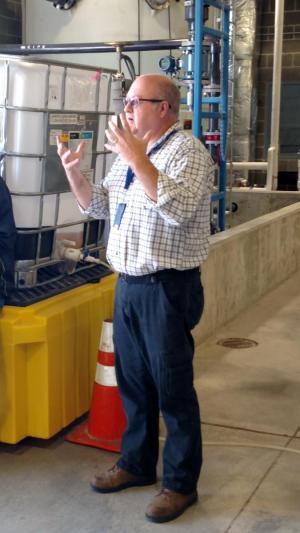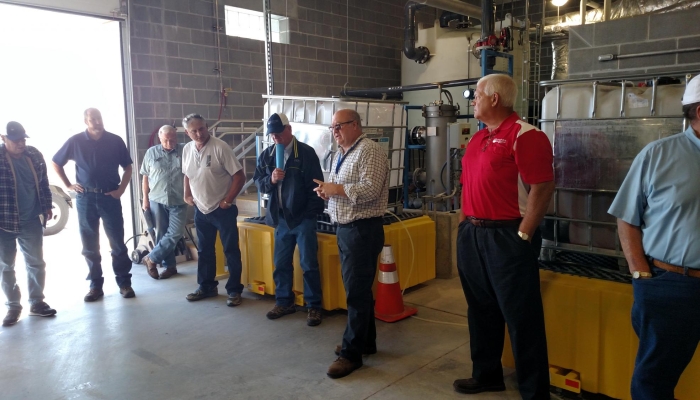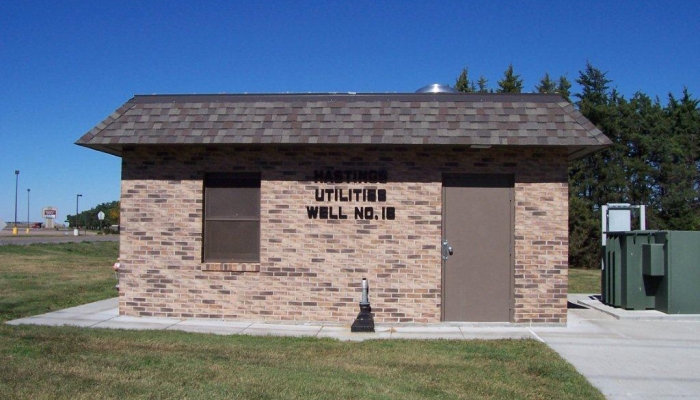Innovation in Nitrate Treatment
Marty Stange, environmental director at Hastings Utilities, presented to the Upper Big Blue NRD board of directors at a recent learning session about the Aquifer Storage and Restoration Project that is improving drinking water in Hastings and the surrounding area. Stange has been with Hastings Utilities for 32 years and says he’s been dealing with the issue of nitrate contamination in the municipal drinking water supply from his first day. Since he began working with the city in 1990, nitrate levels in the groundwater have increased 68 percent. As this level continued to rise, the City of Hastings recognized that they needed short-term and long-term solutions to continue to provide a safe and reliable potable water supply for residents.
 Long-term solutions include working with local growers to implement best management practices to reduce the amount of leaching that would happen going forward in the Hastings Wellhead Protection Area (which is part of the Upper Big Blue and Little Blue NRDs). However, that solution does not reduce the amount of legacy nutrients already in the system applied by the previous generation of growers. The short-term solutions the city considered included drilling new wells (though it would be a challenge to find locations with lower nitrates in the area to draw from and new infrastructure would need to be built) or constructing a nitrate remediation facility (estimated to cost $75 million). Instead, in 2016 they began work on an innovative Aquifer Storage and Restoration (ASR) project, which cost $45 million to complete and $1 million per year to operate.
Long-term solutions include working with local growers to implement best management practices to reduce the amount of leaching that would happen going forward in the Hastings Wellhead Protection Area (which is part of the Upper Big Blue and Little Blue NRDs). However, that solution does not reduce the amount of legacy nutrients already in the system applied by the previous generation of growers. The short-term solutions the city considered included drilling new wells (though it would be a challenge to find locations with lower nitrates in the area to draw from and new infrastructure would need to be built) or constructing a nitrate remediation facility (estimated to cost $75 million). Instead, in 2016 they began work on an innovative Aquifer Storage and Restoration (ASR) project, which cost $45 million to complete and $1 million per year to operate.
The ASR project involves drawing water from the aquifer at different depths (deeper water has less nitrate contamination), treating the water with the highest levels of nitrates with a reverse osmosis system, then blending the two so that the resulting product has a level of nitrate considered to be safe by the EPA (under 10 ppm). Cleaner water is then injected back into the aquifer and stored underground. Higher nitrate water is also stored in an above ground lagoon, where it is used for irrigation in surrounding fields instead of drinking water.
Stange says that the system is working better than they had hoped and several wells that had previously been taken offline due to high nitrates can provide water to the city again. Stange sees the project as a cost-effective solution for the City of Hastings, but that’s not the end of the story. He warns that consuming water contaminated with nitrates even at the EPA threshold of 10 ppm may be linked to negative health outcomes. While there are multiple barriers in place to protect the quality of the water for Nebraskans whose water comes from a municipal source, those whose water comes from a private well (about 20 percent of the population of Nebraska) are on their own when it comes to ensuring that they aren’t consuming dangerous levels of contaminants. (Learn more about our walk-in water testing program.)
Studies are currently underway through the University of Nebraska Medical Center (UNMC) that examine the relationship between nitrates and pediatric cancer, birth defects, and other negative health outcomes including lifetime cancer risk. Stange noted that Nebraska has one of the highest rates of pediatric cancer in the United States and that Adams County has one of the highest rates of pediatric cancer in the state of Nebraska. An additional concern is that increased nitrate in the water leads to the mobilization of naturally occurring elements uranium and selenium in the water, which are also linked to negative health outcomes.
Stange encouraged board members to consider the unintended consequences of poorly managed nitrogen application in Nebraska, including a loss of public confidence in the water system, impacts on public health as well as the economic viability of the state. Stange asked the board, who is responsible for ensuring safe water for Nebraskans? How can we all work together to encourage social change? What will it take to convince people to act on this challenge? He suggested that planning and modeling must be a priority, as access to safe drinking water is vital to Nebraska’s future.

 Long-term solutions include working with local growers to implement best management practices to reduce the amount of leaching that would happen going forward in the Hastings Wellhead Protection Area (which is part of the Upper Big Blue and Little Blue NRDs). However, that solution does not reduce the amount of legacy nutrients already in the system applied by the previous generation of growers. The short-term solutions the city considered included drilling new wells (though it would be a challenge to find locations with lower nitrates in the area to draw from and new infrastructure would need to be built) or constructing a nitrate remediation facility (estimated to cost $75 million). Instead, in 2016 they began work on an innovative Aquifer Storage and Restoration (ASR) project, which cost $45 million to complete and $1 million per year to operate.
Long-term solutions include working with local growers to implement best management practices to reduce the amount of leaching that would happen going forward in the Hastings Wellhead Protection Area (which is part of the Upper Big Blue and Little Blue NRDs). However, that solution does not reduce the amount of legacy nutrients already in the system applied by the previous generation of growers. The short-term solutions the city considered included drilling new wells (though it would be a challenge to find locations with lower nitrates in the area to draw from and new infrastructure would need to be built) or constructing a nitrate remediation facility (estimated to cost $75 million). Instead, in 2016 they began work on an innovative Aquifer Storage and Restoration (ASR) project, which cost $45 million to complete and $1 million per year to operate.The ASR project involves drawing water from the aquifer at different depths (deeper water has less nitrate contamination), treating the water with the highest levels of nitrates with a reverse osmosis system, then blending the two so that the resulting product has a level of nitrate considered to be safe by the EPA (under 10 ppm). Cleaner water is then injected back into the aquifer and stored underground. Higher nitrate water is also stored in an above ground lagoon, where it is used for irrigation in surrounding fields instead of drinking water.
Stange says that the system is working better than they had hoped and several wells that had previously been taken offline due to high nitrates can provide water to the city again. Stange sees the project as a cost-effective solution for the City of Hastings, but that’s not the end of the story. He warns that consuming water contaminated with nitrates even at the EPA threshold of 10 ppm may be linked to negative health outcomes. While there are multiple barriers in place to protect the quality of the water for Nebraskans whose water comes from a municipal source, those whose water comes from a private well (about 20 percent of the population of Nebraska) are on their own when it comes to ensuring that they aren’t consuming dangerous levels of contaminants. (Learn more about our walk-in water testing program.)
Studies are currently underway through the University of Nebraska Medical Center (UNMC) that examine the relationship between nitrates and pediatric cancer, birth defects, and other negative health outcomes including lifetime cancer risk. Stange noted that Nebraska has one of the highest rates of pediatric cancer in the United States and that Adams County has one of the highest rates of pediatric cancer in the state of Nebraska. An additional concern is that increased nitrate in the water leads to the mobilization of naturally occurring elements uranium and selenium in the water, which are also linked to negative health outcomes.
Stange encouraged board members to consider the unintended consequences of poorly managed nitrogen application in Nebraska, including a loss of public confidence in the water system, impacts on public health as well as the economic viability of the state. Stange asked the board, who is responsible for ensuring safe water for Nebraskans? How can we all work together to encourage social change? What will it take to convince people to act on this challenge? He suggested that planning and modeling must be a priority, as access to safe drinking water is vital to Nebraska’s future.



